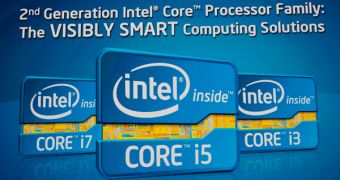As most of you know by now, Intel has decided to limit the overclocking potential of their Sandy Bridge based processors by locking the base clock frequency of their chip, striking terror in the harts of enthusiasts everywhere, but the latest rumors suggest that Intel plans to release a new series of Sandy Bridge processors that will come completely unlocked.
According to the inpai.com.cn website, these new processors will be based on the Sandy Bridge E core that moves the clock generator back onto the motherboard allowing base clock frequency to be changed once again.
In the current Sandy Bridge architecture, the clock generator is placed inside the CPU, Intel locking it so that it limits the overclocking potential of their chips, in order not to cannibalize Nehalem sales, this core remaining Intel's top of the line offering even after Sandy Bridge launches.
Thanks to the locked clock generator, overclocking is severely limited on Intel's Sandy Bridge CPUs, only K models being more overclocking friendly since they come with an unlocked multiplier.
This latest development regarding Sandy Bridge comes just a few days after we reported about a chipset called Intel Z68 that came with what was referred as “Performance Over Clocking” support.
Although it didn't made much sense at the time, now it seems like things are starting to come into place, as removing the clock generator from inside the processor, requires it to be moved back onto the motherboard, the Z68 chipset probably coming with all the necessary modifications to allow for such a change (provided that Sandy Bridge E uses the LGA 1155 socket).
Since the Sandy Bridge E processor is destined to come as a replacement for current Nehelem based chips, enabling full overclocking support would make sense, since Nehalem would probably be phased out as soon as Sandy Bridge E comes to market.
Unfortunately, these are all the informations that we have right now, but we will find soon enough if these latest rumors about Sandy Bridge are true.

 14 DAY TRIAL //
14 DAY TRIAL //